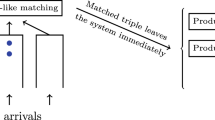Abstract
This paper studies M/G/1 retrial queues in which there are two arrival flows, i.e., incoming calls made by regular customers and outgoing calls made by the server in idle time. The stationary analysis of this system has been carried out in a recent paper by Artalejo and Phung-Duc (Appl Math Model 37(4):1811–1822, 2013). In this paper, we obtain a decomposition property where we prove that the queue length is decomposed into the sum of three independent random variables with clear physical meaning. We then derive scaling limits for the queue length distribution under some extreme conditions (i) heavy traffic, (ii) slow retrials and (iii) instantaneous connection to outgoing calls. Furthermore, we also investigate the convergence of our model to that without outgoing calls.





Similar content being viewed by others
References
Artalejo, J. R., & Gomez-Corral, A. (2008). Retrial queueing systems: A computational approach. Berlin: Springer.
Artalejo, J. R., & Phung-Duc, T. (2012). Markovian retrial queues with two way communication. Journal of Industrial and Management Optimization, 8(4), 781–806.
Artalejo, J. R., & Phung-Duc, T. (2013). Single server retrial queues with two way communication. Applied Mathematical Modelling, 37(4), 1811–1822.
Aguir, S., Karaesmen, F., Aksin, O. Z., & Chauvet, F. (2004). The impact of retrials on call center performance. OR Spectrum, 26, 353–376.
Arrar, N. K., Djellab, N. V., & Baillon, J. B. (2012). On the asymptotic behaviour of M/G/1 retrial queues with batch arrivals and impatience phenomenon. Mathematical and Computer Modelling, 55, 654–665.
Bhulai, S., & Koole, G. (2003). A queueing model for call blending in call centers. IEEE Transactions on Automatic Control, 48, 1434–1438.
Choi, B. D., Choi, K. B., & Lee, Y. W. (1995). M/G/1 retrial queueing systems with two types of calls and finite capacity. Queueing Systems, 19, 215–229.
Deslauriers, A., L’Ecuyer, P., Pichitlamken, J., Ingolfsson, A., & Avramidis, A. N. (2007). Markov chain models of a telephone call center with call blending. Computers and Operations Research, 34, 1616–1645.
Falin, G. I., & Templeton, J. G. C. (1997). Retrial queues. London: Chapman and Hall.
Falin, G. I. (1979). Model of coupled switching in presence of recurrent calls. Engineering Cybernetics Review, 17, 53–59.
Falin, G. I., Artalejo, J. R., & Martin, M. (1993). On the single server retrial queue with priority customers. Queueing Systems, 14, 439–455.
Lee, H. W., Lee, S. S., Park, O. J., & Chae, K. C. (1995). Analysis of the MX/G/1 queue with N-policy and multiple vacations. Journal of Applied Probability, 31, 476–496.
Phung-Duc, T., Masuyama, H., Kasahara, S., & Takahashi, Y. (2009). Performance analysis of optical burst switched networks with limited-range wavelength conversion, retransmission and burst segmentation. Journal of the Operations Research Society of Japan, 52, 58–74.
Phung-Duc, T., & Kawanishi, K. (2014). An efficient method for performance analysis of blended call centers with redial. Asia-Pacific Journal of Operational Research, 31, 1440008. (33 pages).
Phung-Duc, T., Rogiest, W., Takahashi, Y., & Bruneel, H. (2014). Retrial queues with balanced call blending: Analysis of single-server and multiserver model. Annals of Operations Research. doi:10.1007/s10479-014-1598-2.
Sakurai, H., & Phung-Duc, T. (2014). Two-way communication retrial queues with multiple types of outgoing calls. Top. doi:10.1007/s11750-014-0349-5.
Tran-Gia, P., & Mandjes, M. (1997). Modeling of customer retrial phenomenon in cellular mobile networks. IEEE Journal on Selected Areas in Communications, 15, 1406–1414.
Acknowledgments
The authors appreciate constructive comments of the three anonymous reviewers which help us improve the presentation of the paper. Tuan Phung-Duc was supported in part by JSPS KAKENHI Grant Number 26730011.
Author information
Authors and Affiliations
Corresponding author
Appendix: Uniform convergence
Appendix: Uniform convergence
In order for the interchange between limit and integration uniform convergence of the integrand is required. To this end, we prove the following two lemmas.
Lemma 1
(Page 30 in Falin and Templeton 1997) If \(\beta _1^2 < \infty \) then we have
uniformly with respect to \(s \in [0,M]\).
Proof
A proof is given in page 30 of Falin and Templeton (1997). \(\square \)
Lemma 2
If \(\beta _2^1 < \infty \) then we have
uniformly with respect to \(s \in [0,M]\).
Proof
Letting \(g(t) = \beta _2 (t) -1 + \beta _2^1 t\), because \(\beta _2^1\) exists, we have
We have \(g^{\prime \prime } (t) = \beta _2^{\prime \prime } (t)> 0\) for any \(t > 0\). Thus, \(g^\prime (t) \ge g^\prime (0) = 0\) for \(t \ge 0\). Therefore, we have
where \(M\) is an arbitrary fixed positive number. Since \(\frac{g(\varepsilon M)}{\varepsilon M} \rightarrow 0\) as \(\varepsilon \rightarrow 0\), we have
uniformly with respect to \(s \in [0,M]\) for any \(M>0\). \(\square \)
Rights and permissions
About this article
Cite this article
Sakurai, H., Phung-Duc, T. Scaling limits for single server retrial queues with two-way communication. Ann Oper Res 247, 229–256 (2016). https://doi.org/10.1007/s10479-015-1874-9
Published:
Issue Date:
DOI: https://doi.org/10.1007/s10479-015-1874-9




